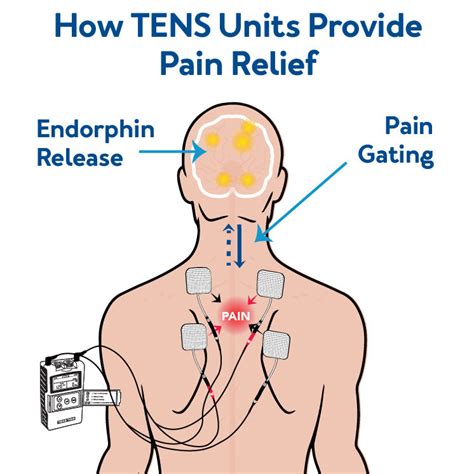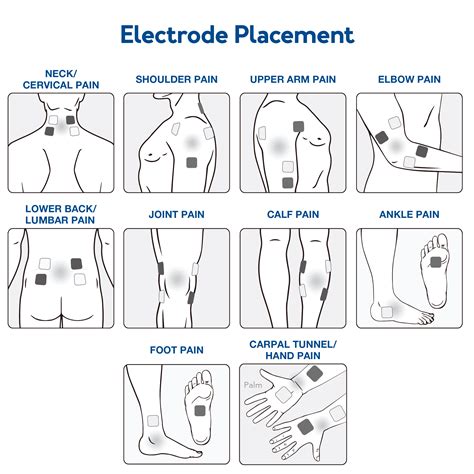Intro
Discover how TENS units relieve pain through electrical impulses, utilizing transcutaneous stimulation, pain relief therapy, and muscle relaxation techniques for chronic pain management and rehabilitation.
The use of TENS units has become increasingly popular in recent years, particularly among individuals seeking alternative methods for managing chronic pain. TENS, which stands for Transcutaneous Electrical Nerve Stimulation, is a non-invasive technique that involves the use of a small device to deliver electrical impulses to the body. These impulses are designed to interfere with pain signals sent to the brain, providing relief from various types of pain. Understanding how TENS units work is crucial for those considering this method as part of their pain management strategy.
TENS units are simple to use and can be applied in the comfort of one's own home, making them a convenient option for many. The basic principle behind TENS therapy is the gate control theory of pain, which suggests that certain nerve fibers can block or "gate" pain signals traveling to the brain. By stimulating these nerves with electrical impulses, TENS units can effectively reduce the perception of pain. This method has been used for decades and is recommended by healthcare professionals for various conditions, including arthritis, fibromyalgia, and post-operative pain.
The versatility and effectiveness of TENS units have led to their widespread adoption. They are particularly appealing because they offer a drug-free alternative to pain management, which can be especially beneficial for individuals who prefer not to rely on medication or are experiencing adverse side effects from pharmaceuticals. Furthermore, TENS therapy can be tailored to the individual's needs, with adjustable intensity and frequency settings allowing for a personalized approach to pain relief.
Introduction to TENS Unit Mechanism

The mechanism by which TENS units work involves the placement of electrodes on the skin near the area of pain. These electrodes are connected to the TENS device, which generates electrical impulses. When the device is turned on, the impulses are transmitted through the electrodes to the nerves in the targeted area. The frequency and intensity of these impulses can be adjusted, allowing users to find the most comfortable and effective settings for their specific needs.
Types of TENS Units
There are several types of TENS units available, each designed with specific features and functionalities. Some units are designed for general use and can be applied to various parts of the body, while others are specialized for certain areas, such as the back or joints. The choice of TENS unit depends on the individual's needs and the nature of their pain. Healthcare professionals can provide guidance on selecting the most appropriate unit and settings for optimal pain relief.Benefits of Using TENS Units

The benefits of using TENS units are numerous and well-documented. One of the primary advantages is the ability to manage pain without the use of drugs, reducing the risk of side effects and dependency. TENS therapy is also non-invasive, making it a safer alternative to surgical interventions. Additionally, TENS units are portable and can be used at any time, providing users with the flexibility to manage their pain as needed.
How to Use a TENS Unit Effectively
To use a TENS unit effectively, it's essential to follow a few guidelines. First, the device should be used in a comfortable and relaxed environment. The electrodes should be placed on clean, dry skin, and the settings should be adjusted gradually to find the optimal level of stimulation. It's also important to consult with a healthcare professional before starting TENS therapy, especially if you have any underlying medical conditions or are using other treatments.Common Applications of TENS Units

TENS units have a wide range of applications and can be used to manage various types of pain. They are commonly used for chronic pain conditions such as lower back pain, arthritis, and fibromyalgia. TENS therapy is also effective for acute pain, including post-operative pain and pain associated with injuries. Furthermore, TENS units can be used during labor to help manage contractions and reduce the need for epidural anesthesia.
Potential Side Effects and Considerations
While TENS units are generally safe and well-tolerated, there are some potential side effects and considerations to be aware of. Skin irritation or allergic reactions to the electrodes can occur, although this is rare. It's also important to avoid using TENS units near open wounds or on areas with reduced sensation. Pregnant women and individuals with pacemakers or other implanted medical devices should consult with their healthcare provider before using a TENS unit.Combining TENS Therapy with Other Treatments

TENS therapy can be used in conjunction with other treatments to enhance its effectiveness. Physical therapy, exercise, and relaxation techniques such as meditation or deep breathing can complement TENS therapy, providing a comprehensive approach to pain management. Additionally, some individuals may find it beneficial to use TENS units in combination with traditional pain relief medications, under the guidance of a healthcare professional.
Future Developments in TENS Technology
The technology behind TENS units is continually evolving, with advancements aimed at improving efficacy, convenience, and user experience. Future developments may include more sophisticated devices with automated settings and real-time feedback, as well as the integration of TENS technology with other therapeutic modalities such as heat or cold therapy. As research continues to uncover the full potential of TENS therapy, it's likely that its applications will expand, offering new hope for individuals living with chronic pain.Conclusion and Next Steps

In conclusion, TENS units offer a valuable tool for managing chronic and acute pain, providing a non-invasive, drug-free alternative to traditional pain relief methods. By understanding how TENS units work and their benefits, individuals can make informed decisions about incorporating this therapy into their pain management strategy. For those considering TENS therapy, consulting with a healthcare professional is the first step, followed by selecting an appropriate device and learning how to use it effectively.
Final Thoughts on TENS Unit Therapy
TENS unit therapy has the potential to significantly improve the quality of life for individuals living with pain. Its effectiveness, combined with its safety and convenience, makes it an attractive option for those seeking alternative pain management solutions. As with any therapeutic approach, it's essential to have realistic expectations and to be patient, as it may take some time to find the optimal settings and to experience noticeable relief.What is the primary mechanism by which TENS units work?
+TENS units work by stimulating nerves with electrical impulses, which can block pain signals sent to the brain, providing relief from various types of pain.
Are TENS units suitable for everyone?
+No, TENS units are not suitable for everyone, particularly those with pacemakers or other implanted medical devices, and pregnant women, who should consult their healthcare provider before use.
Can TENS units be used in conjunction with other pain management treatments?
+Yes, TENS units can be used alongside other treatments, such as physical therapy, exercise, and traditional pain relief medications, to provide a comprehensive approach to pain management.
We invite you to share your experiences with TENS unit therapy and any questions you may have about this topic. Your input can help others who are considering TENS therapy as part of their pain management strategy. Additionally, if you found this information helpful, please consider sharing it with others who may benefit from learning about the potential of TENS units in managing pain.
